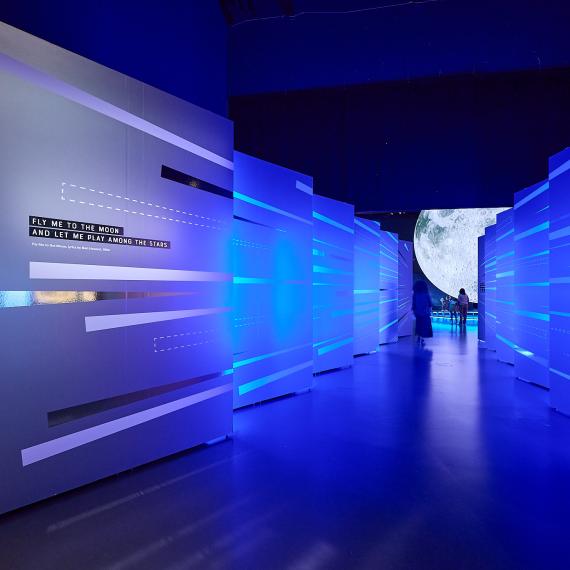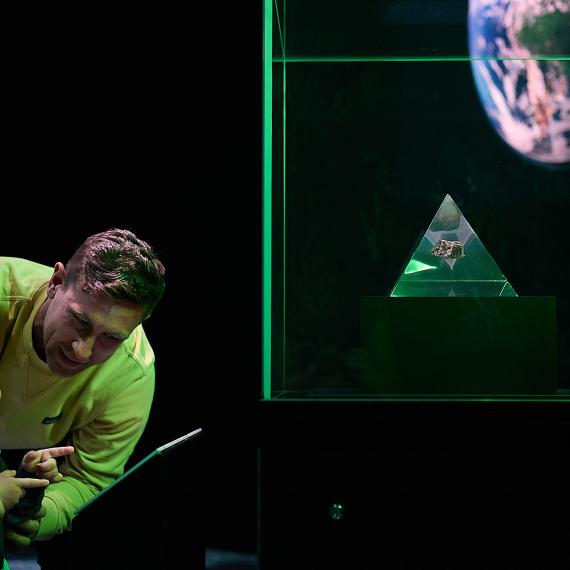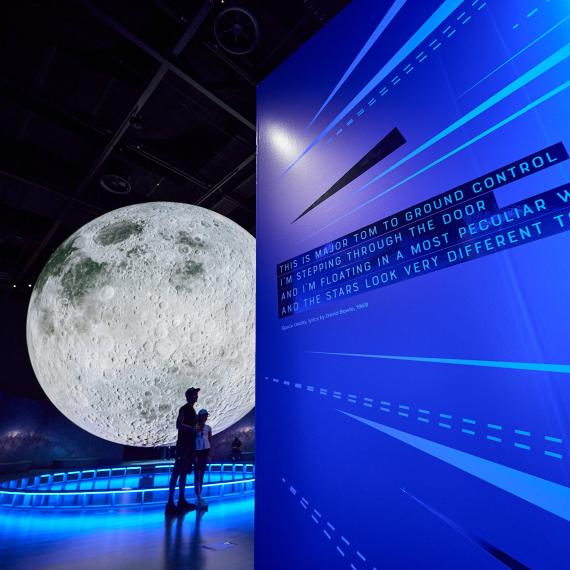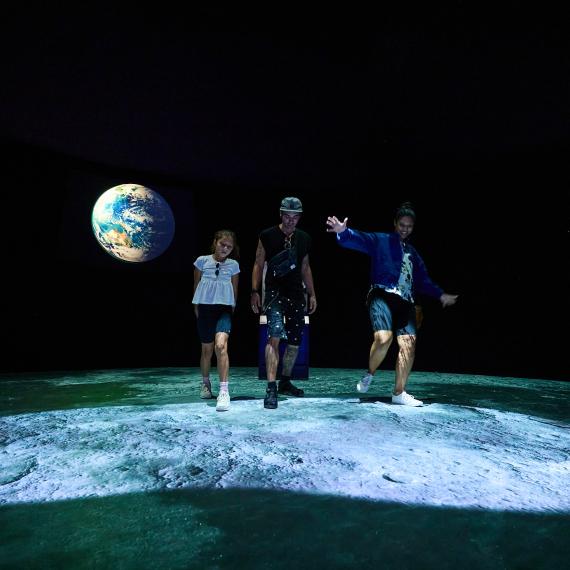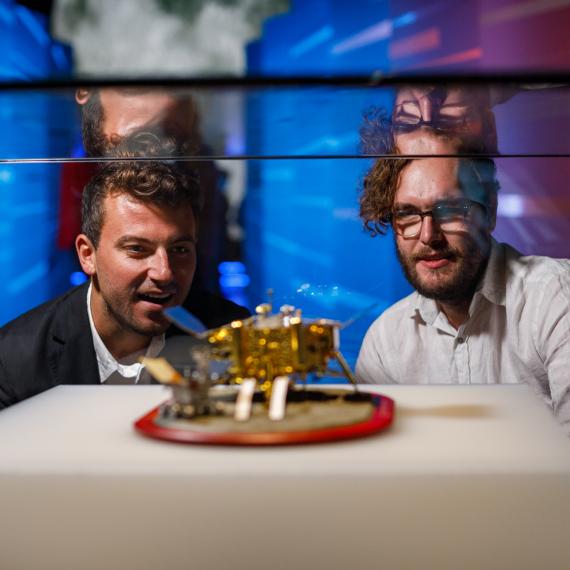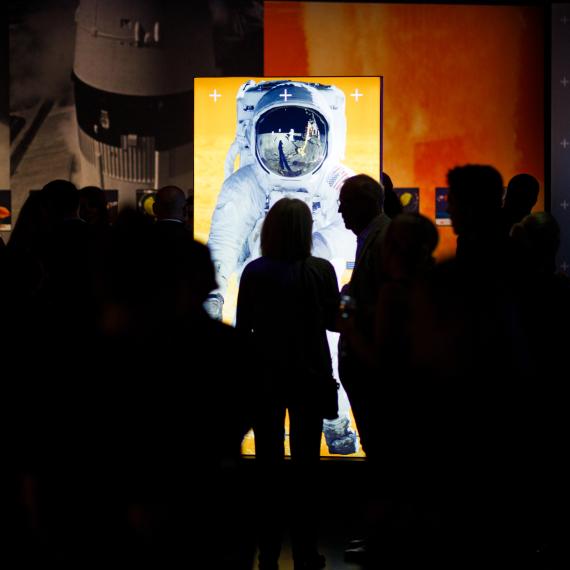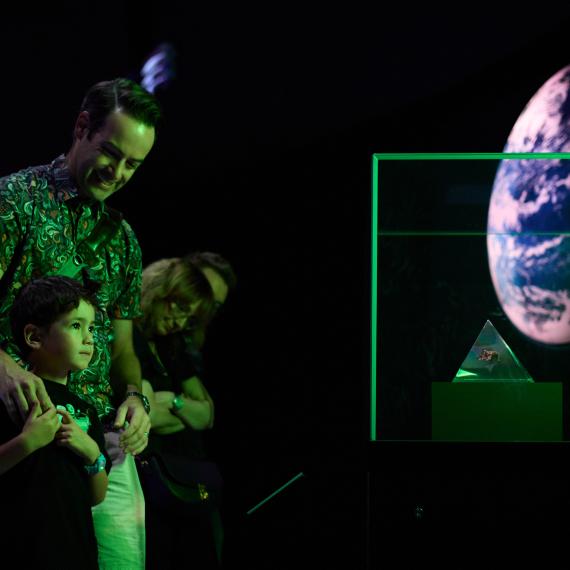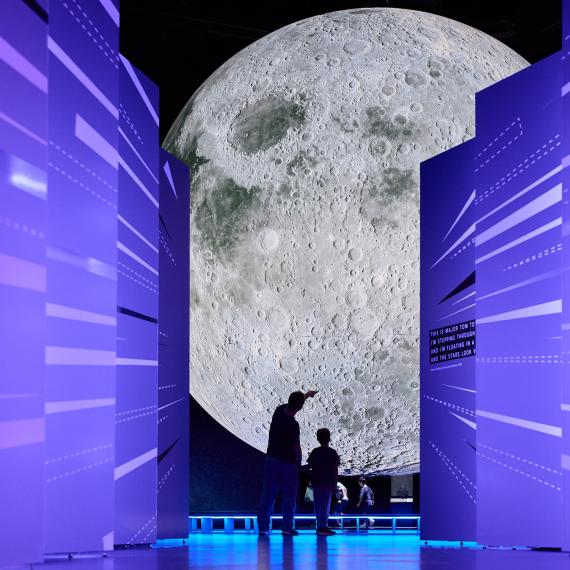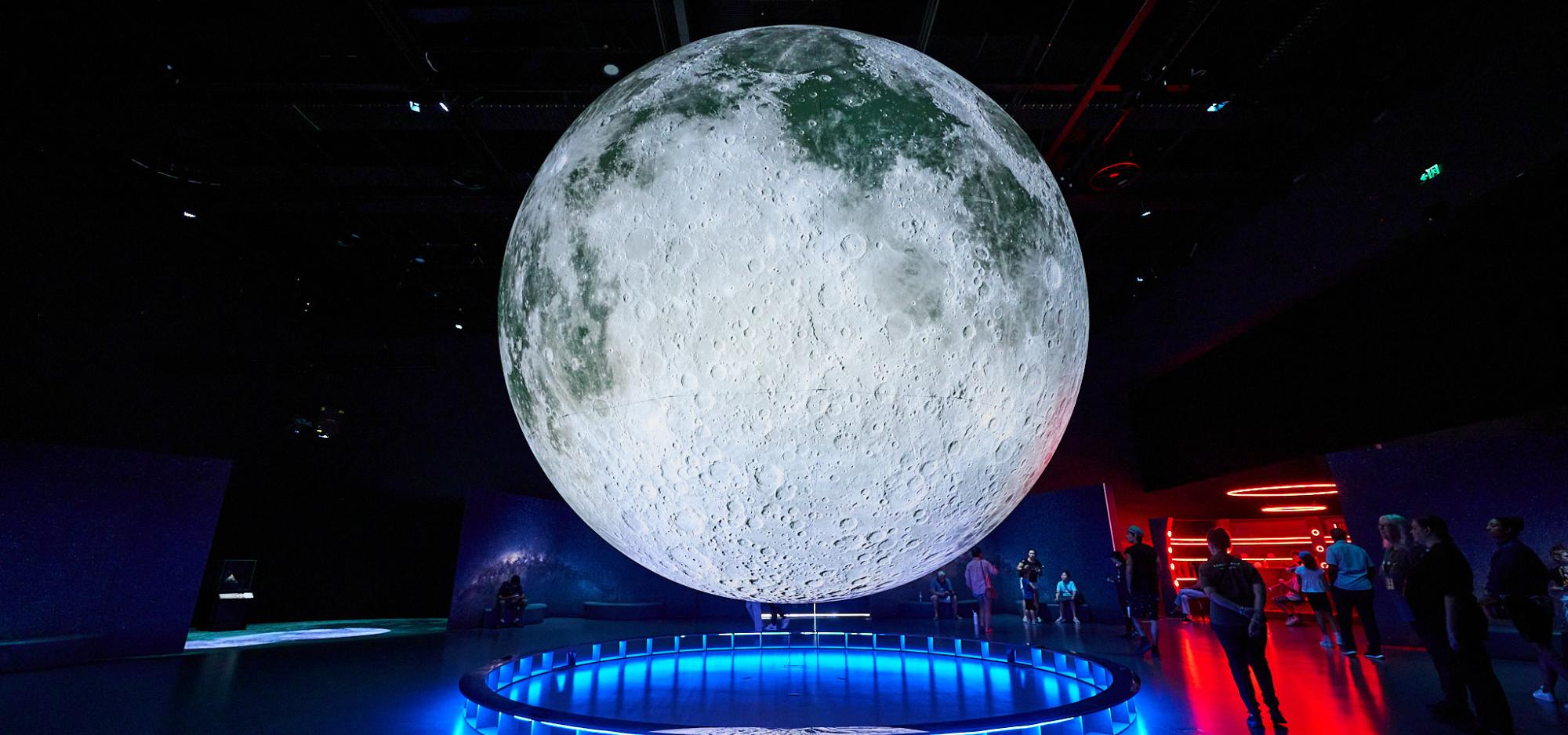
Lunar Conspiracy Theories with Richard Tonello
Join Richard Tonello as they discuss and debunk all things lunar conspiracy, from the flapping flag to flat earth theories, missing stars and the moon's reflectivity index.
This talk was recorded as a part of the Lunar Lounge series for the To The Moon exhibition.
-
Episode transcript
Introduction:
You're listening to the Western Australian Museum Boola Bardip talks archive. The WA Museum Boola Bardip hosts a series of thought-provoking talks and conversations tackling big issues, questions, and ideas, and is delighted to be able to share these with you through the talks archive. The talks archive is recorded on Whadjuk Nyoongar Boodjar. The Western Australian Museum acknowledges and respects the traditional owners of their ancestral lands, waters and skies.
Event MC:
Good evening, everybody and welcome to the WA Museum Boola Bardip and this Lunar Lounge event. Before we get started with our guest speaker this evening, I'd just like to take a moment to acknowledge the lands on which we're gathered and learning on here tonight, the lands of the Whadjuk people of the Nyoongar nation. May we pay respects to elders past and present, and extend those respects to any First Nations folks here with us tonight.
So tonight we have a very exciting guest speaker. This is Rick Tonello, who will be taking us through lunar conspiracy theories and debunking them. Please make Rick feel welcome.
Audience:
[applause]
Richard (Rick) Tonello:
Thank you. Thank you for the applause, even though I haven't done anything. But I'll take your applause nevertheless. So, yes, my name is Rick Tonello. I'm the chief astronomer at a place called the Gravity Discovery Centre Observatory. I'm blessed by some of my colleagues who join me tonight because, well, they're not rostered on this evening.
So, this evening, what we're going to be talking about is, of course, we're going to be addressing the lunar conspiracy theories. So, the great...
[music plays]
...conspiracy. Did we really go to the moon? Now, I know there are people out there in today's 21st century who deny we've gone to the moon. And to me, that fills my heart with such despair. And just[...] ah, God, really? Get with the times, people.
But I do have to ask, is there anyone here who denies we've gone to the moon?
Do we have[...] actually, no, let me, let me rephrase the question. Do we have anyone here that has their doubts about going, that we went to the moon? No? Oh, good. So, we're like-minded people so we’re going to have a good time. Because if I had to challenge someone to a fight, that would have made ,actually, it a bit more interesting.
Now I do have to ask the same question in the same breath. Do we have any flat earthers in the audience? Anyone who believes the earth is completely flat because if you're a flat earther, you can just bugger off because I don't want you here, seriously, just ruin the night, and that's it, it’s all downhill from there.
So, what we want to do is we want to look at some of these popular conspiracy theories that have been going around since that epic journey that occurred, well, the first journey to the moon started in 1968 and that of course, was Apollo 8. That usually gets overlooked, but that was the pioneering journey to actually send humans around the moon and back. The landing didn't actually happen until Apollo 11, as we all know. So, what we'll start doing is we'll have[...]
I want to start off with this quote. Now, this quote occurred to me, no, not occurred, it actually was, not sort of directed to me, just sort of out there in the open. I was traveling with my family at, in the United States way back in 2018, and we were at a place called Barringer Crater in Arizona, and we were at this amazing place right near the crater, and it's got this amazing discovery gallery and from one section that dealt with cratering on the moon, this rather weird American lady emerged from that section. In a very loud American voice, she proclaimed, quote: ‘I'm a scientist, and I know for a fact we've never, ever gone to the moon. It's impossible’.
Now, that's possibly one of the worst things you can say in any proximity around me, because that just triggers me instantly. So, I did confront her. We did have a robust conversation, and eventually I walked away. Unfortunately, I didn't convert her, but I did convert another lady who was watching from a safe distance, and she actually shook my hand, thanked me for convincing her that we actually did go to the moon because before she arrived that day, she didn't believe we went.
A friend of mine, just as a side note, actually, he pointed out to me, he said ‘are you nuts? What's wrong with you? You know, starting a fight like that in the United States?’ And I said ‘why?’ I said, ‘I'm championing science, damn it’. And he said, ‘you were in Arizona. She could have pulled out a gun and shot you’. So thankfully, no bullet holes, therefore, I win the argument.
Anyway, so moving on. So, let's[...] some of the claims that the conspiracy theorists make. So, there's a number of them. There's of course, you know, how could they go to the, to the moon with such primitive computers? What's the other one? Who took the pictures of Neil Armstrong climbing down the ladder? The boot prints on the soil are too, too sharp and precise. Okay. Oh, what's this one? The moon doesn't really exist, and the Earth is flat. Okay, now we won't talk about, we'll save that one for another conversation, okay?
But why haven't we been back? And the list goes on and on and on and on and on and on, blah blah blah blah blah blah blah.
Let's address a few of them. We'll pick out[...] I picked out some of the choice ones that are a lot of fun to analyse and, you know, really bring it home.
So, the flag is moving. This is one of the ones that really gets people, you know, interested because they see the flag moving and there's no doubt the flag does move. It actually flaps around. So, let's have a look. But before we understand or seeing the flag moving the actual footage of it that has also been restored, we need to understand the mechanics of the flag.
Now, the flag is a very simple structure. There's the flag itself. There's the surface of the moon. So, we have the up-and-down stick, also known as the flagpole. We have the side-to-side stick which holds the flag unfurled. And then we have the flag itself. Now if we didn't have the side-to-side stick, the flag would just hang down like a bit of wet lettuce, and we wouldn't be able to see the stars and stripes, and the United States wouldn't have their moment in their sun.
So, also we have the moon. Very important because you’ve got to stick the flag somewhere, otherwise it'll just be floating in space. So, with that in mind, with the up-and-down stick, side-to-side stick and the flag, let's look at the footage. So, the conspiracy theorist, when they saw this footage, they saw the flag moving. And in their minds they said, how can the flag move if there's no air on the moon? Somebody must have left the door open to the sound stage, and a gust of wind came along and started flapping the flag about.
Well, let me tell you this. There is no wind on the moon. There is no atmosphere. And yes, it is flapping around because look what the astronauts are doing. They're sticking it down and they're twisting it around. As they're twisting it around, they’re causing the side-to-side stick to wave around. And as it waves around, it transfers energy into the flag, causing it to flap. Now, if anyone used to watch that awesome show MythBusters, they did a whole show on this about debunking the lunar conspiracy theories. And they did do this test in a vacuum test chamber where they could actually flap the flag around.
And the flag didn't move, but they saw an interesting thing. The flag took a little bit longer to come to rest. Why? Because there is no air on the moon. There is no drag to slow it down. If we were to wave a flag around here right now, it would come to a rest in very short order because it is surrounded by air molecules which will induce drag and cause it to stop, but in a vacuum, it'll tend to flap around just a little bit longer.
So yes, the flag is moving, but the conspiracy theorists have got it completely wrong. So, it does flap around, but there is no air on the moon. So, this was actually filmed on location, I must say.
Now where are the stars? This is another good one. So, in the picture we'll go back to that same picture again. Here, of course, we've got the surface of the moon. We have the flag and, in the background, well, where are the stars? This is space. Okay, space is supposed to be full of stars. There is supposed to be stars shining brightly across in the dark depths across here.
But where are they? Well, I can tell you they're there. It's just that they’re really faint. But we can see one star and that star happens to be the sun. Now, I don't know the last time you’ve seen the sun, but it's really darn bright. In fact, it's colossally bright as the brightest thing that, you know, is close to us. And during the day, because the light from the sun goes through our atmosphere, the light scatters through the air molecules. It rejects some colours and it absorbs the blue colours, which is why we have a blue sky, but the atmosphere is still transparent. Have you ever seen the occasions when you go out in the morning, and you still see the moon up in the daytime sky? Well, there's a good point. There's a good bit of evidence because the atmosphere is transparent and because the moon is relatively bright, it allows the light reflected off the moon to go through this blue sky and we can see it.
But stars are very, very small. Or not so much small, they are actually other suns, but stars are very faint because they are very far away. Now getting back to that picture, there it is, there.
It's also down to photography. You see, when you take a picture, you want to get the exposure just right. You don't want to have it overexposed or underexposed, and in this case, we wanted to see the terrain of the moon. In fact, the screen really doesn't do it justice. On my screen it looks fantastic. On that screen it's a little bit questionable, but there you go. But when we look at the surface of the moon, we can see the boot prints, we can see the contours, we can see the rocks, and even if you look very, very carefully, there is a cable running down here. And that is the cable to the remote television set that filmed those planting the flag scene that we saw earlier. But if we were to want to take pictures of the stars, we would have to horribly overexpose the foreground and the flag to something that resembles almost like this.
And of course, even then we wouldn't be able to see the stars. We may be able to see a few bright ones, but it wouldn't be filled with stars. So, there is one star, like I said, it is the sun.
What else do we have? Oh yes, studio lighting was used. This is a little bit more complex, so how can we see the astronauts standing in the shadow of the Lunar Excursion Module? So, let's have a look. There’s this famous picture here of an astronaut descending down the ladder of the LEM, or the Lunar Excursion Module. And that very shapely derriere right there, of course, belongs to Buzz Aldrin. That is his butt. Now, how can we see Buzz Aldrin in the shadow of the LEM? You see some of the conspiracy theorists say, Buzz Aldrin and that backside of the[...] the backside of the LEM and his backside, should be in complete darkness, but, well, we've got a number of things at play here. First and foremost, we have, well they said there was studio lighting, lighting him up, therefore it was fake. But no, that's not how it works.
So, you see, the moon is actually reflective. It's, when you compare it to other reflective things like aluminium foil or even white paint, it's not that reflective at all. In fact, its reflectivity index, its albedo, is only about 12% more reflective than coal. But because it is in full sun, it is a white surface area, and the surface also undulates as well, the surface of the moon is not smooth and polished like it was once thought, the light from the sun bounces off the actual surface of the moon and into the shadow and on to Buzz Aldrin's butt, so we can actually see him.
It's also, again, down to photography. You'll notice that the foreground here or the sorry, the background here, of the moon is actually a teensy bit overexposed because the main photo they wanted to take was the LEM and Buzz Aldrin coming down the ladder. This point right here, as he's poised to take the step to become the second person to step onto another, another body in our solar system, well, he took a point. He took a moment there just to pause at the bottom of the ladder, and as he said, quote: ‘he said he took a slight moment just to fill up his urine bag’. So, he may have been the second person to walk on the moon, moon, but he was the first person to take a whiz on the moon. So well done Buzz, you're going to be the first at something.
Now, moon landing was CGI. God, I love this. This is so good. So, you know, apparently, according to the conspiracy theorist, this, the, this image here in 1969 was computer generated. Okay. And they kind of contradict themselves because, you know, they say the computer power was too slow and too primitive, and yet they say CGI did this.
Let me compare some of the CGI throughout the ages. So also in 1969, I'm just putting that there as a reference, also in 1969 was the pioneering space show known as Star Trek the Original Series. Let's have a look at their CGI. Bit primitive, but just the same, it was cutting edge for the day. People got very excited by this, but let's advance in time to, let's say, 1985.
If you’re my vintage, you'd remember a rock band called Dire Straits, and they had a film clip for one of their songs called Money for Nothing, and that was cutting edge technology. Everyone got so wigged out by the characters in this video clip, made for MTV, were all computer generated, and people were just flipping out about that. What an exciting future we have! This was CGI back in 1985. A bit of a difference.
Let's proceed now into, well, our past, but far into the future, from 1985 to 2001. Well, 2001, the computing power had skyrocketed. We now had gaming consoles and home computers, and it was even the advent of the smaller mobile phones. But let's have a look from the famous PlayStation 1 video game of Harry Potter.
This is PS1 Hagrid. Wow! Back in those days it was really good. But nowadays I actually wake up looking like that some mornings thinking, man, I feel like PS1 Hagrid. But just the same, you can put them together and it, you know, it almost seems legit. These people believe that. I'm sure if you put that on truth social and people might say yes, Hagrid was really on the moon. Anyway, moving on.
Now, the Russians. This is one I addressed the lady in Arizona when I challenged her because I approached her after she proclaimed, ‘I'm a scientist and we've never, ever gone to the moon. It's impossible’. I walked right up to her. Well, first of all, I was interrupted by my wife because my head snapped up. She said it once, and ‘I'm a scientist, and you know, there's people never been to the moon. Yak, yak yak’. And I thought, did I really hear that?
And then as she walked closer to me, she said it again and it was louder because of the proximity. It was then that I decided to take a step in the direction of the offending voice, and before I could take two steps, I still don't know how she did it, my wife appeared like Harry Potter style, just sort of she was there waving a finger, threatening me saying, ‘don't you dare. Don't! Leave it out!’ I was like, nope.
So, I walked around her and I walked right up to this lady. I said, I was very polite, you know, I said, ‘good morning, ma'am’. She said, ‘good morning’. I said, ‘look, I couldn't help but overhear your, your rather brash statement, “You're a scientist”, and yet you deny we've gone to the moon’. I said, ‘I'm an astronomer. I know we've gone to the moon. But please, scientist to scientist, tell me your reasoning. Why do you think we haven't gone to the moon, in a scientific manner?’
She started then proclaiming, oh well, you know, the government's untrustworthy. And I said, ‘oh, more incompetent, but, you know, let's, let's go with untrustworthy’. ‘Yes. Well, what about those alien bodies they had in Area 51 and all the alien tech, yak, yak yak’. And I knew for then she’d obviously left her tinfoil hat at home that morning.
So anyway, I let her have her piece. And then I said, ‘that's great, you never answered the question, but let's[...]’ I saw this as an opportunity to teach. Not only am I an astronomer, I'm an educator and a communicator. And I thought, this is a great opportunity, maybe change someone's mind and set them on the right course. So, I said to her, I said, ‘look, allow me to, you know, put my point’ and she says, ‘okay’. And I said, ‘I'll give you two words, we'll cut right to the chase: The Russians’. And she goes, ‘what have they got to do with them?’ ‘They've got everything to do with it. Allow me to explain’.
So, this is roughly what I said, and maybe not so many words here. So, way back when, in the early 60s, in fact, just after the Second World War, the former Soviet Union and of course, the United States were, well, Cold War rivals, and they were at loggerheads with one another and they got to a point where, well, in October 1962, the Cold War almost became hot, nuclear hot.
You see, this was the time of the Cuban Missile Crisis, where the Soviet Union was shipping their intermediate range intercontinental, intercontinental ballistic missiles to Cuba, which is literally on the doorstep of the continental United States. And their missiles were in minutes of striking distances to places like New York and Washington and Atlanta and Denver and all across the eastern and western seaboards, raining hellfire down on, on America.
And, of course, the president of the time, the late John F Kennedy, wouldn't stand for this. So of course, he set up a naval blockade. So, he started up the blockade, and this was where the two superpowers held the world to ransom for 13 days. They were teetering on the brink of nuclear destruction. Russia threatened them with all that nuclear war and they kept iterating, iterating, saying that if you do not move your ships and let us pass through, we're going to bomb you. Thankfully, after the 13 days, there was a resolution and Premier Khrushchev agreed to remove said nuclear weapons and things began to de-escalate.
But it was just a month before the Cuban Missile Crisis that John F Kennedy made his famous speech at the Rice University, the, you know, ‘we choose to go to the moon not because it is easy, but because it is hard’. Well, that's where he set the course for these two nations to race to the moon. Far more peaceful, far more productive.
Now, thankfully, they decided to launch other types of rockets, not the ones tipped with nuclear missiles ready to destroy cities. So, these two rockets, the famous N1, which was the Russian, Soviet rocket. [coughs] Excuse me. This was a monster,powerful rocket. This was the Russians lunar rocket. The Americans had, of course, the famous Saturn V. Both of them wonders of engineering. I've seen one of these in real life. And this thing is monstrous. The first stage, from the bottom of the engine bells up to the first stage interface right here, that, if you ever come up to the Gravity Discovery Centre, that is the height of our tower, which is 45 metres high.
The entire rocket itself is 110 metres tall. It weighs 3000 tonnes at liftoff, fully fuelled, and it accelerates, the first stage accelerates the rocket to a little over 8500 kilometres per hour to achieve orbital velocities. Now, this was the hardest part of the mission, is heaving this warship-mass rocket up into orbit. The rest of it was easy. You don't have to use as much fuel. You don't have to use as much thrust because you're up in space.
But what I'm trying to get at here is both countries had technology comparable to one another. They both had big, powerful rockets. They both had active space programs. They were both racing to the moon. And so, unfortunate for the Soviets that the N1 rocket had computer problems. They must have been running an early version of windows or something like that, because their engine management computer seemed to have shut down a number of their rocket motors in the first stage. So after about 90 seconds of flight, it became unstable, it ruptured a whole bunch of fuel lines, and the thing exploded like a giant, expensive firework.
The second one that they launched didn't even make it off the launch pad. It tried to heave itself up, but then it came crashing back down, which totally destroyed the launch facility and set the Soviets back about 18 months in their lunar program.
But the Saturn V pretty much flew with a perfect flight record, which was absolutely incredible for a machine this large and complex of the day, it was a wonder of engineering. So, they had technology comparable to one another. And this is the lunar flight plan. So as the, as the Apollo mission was flying to the moon in what we call TLI or Trans Lunar Insertion, as they were traveling to the moon, they were sending back data and telemetry back to planet Earth, back to mission control.
And the primary receiving station, of course, was the Goldstone antenna in Southern California. It was picking up communications, data telemetry about the spacecraft, about the bio-signs of the astronauts, stuff that could not be replicated. But there were other places in the world because the Earth turns on its daily rotation and of course, other places, Australia was involved, especially with Parkes in New South Wales. And of course, little known, in Carnarvon, just up north, was a major tracking and capcom station for not just the Apollo missions, but for the earlier Gemini missions. So, we had not just America that had the technology to listen and communicate. Australia could do so, and so could the Russians. The Russians were listening in. In fact, their listening stations were listening to all the data and telemetry and coming back, and if they suspected any form of underhanded skullduggery on the part of the Americans, they would have been the first ones to blurt this out to the world community and saying ‘guess what we found? We found them spending eight days in orbit around planet Earth. They never went anywhere near the moon’.
But they didn't. You see, this was this was actually an article, a front page, but very, very small in the front page of the state-run newspaper called Pravda, on the 22nd of July, the day after they touched down.
And of course, if anyone can read Russian, which I certainly can't, that's what Google translates for, the headline reads First Lunar Expedition, where the actual engineer who wrote this, who was actually a hero of the Soviet Union, he actually wrote about what they did and how brave they were. And also, he wished them a safe return for the Apollo mission, which was great.
So, for that briefest moment, that Cold War just began to thaw out a little bit. And there was, even with the, the cosmonauts and the astronauts on both sides, there was an esprit de corps there, which unified them in some way where they, there was a mutual respect for one another, but also in the greater global community where people of other countries, when the Apollo astronauts came back and they visited dignitaries and the first thing they noticed, they said, when they shook hands of these dignitaries, it's like, we did it! We did it! It wasn't like, congratulations, America, you did it, well done. We did it! Humanity went to the moon. We all went along for the ride, which seemed to somehow unify the world for just a briefest moment. But maybe that's something that could happen in the future. Maybe when we go to Mars, maybe when we go beyond.
And now, to finish up, because I think I've been yakking for quite a while. Yes, I have.
So, 62nd conspiracy slam. [clears throat] Excuse me, I need to have a drink, just a minute.
A bit of audience participation. Who has their phone with them? I know that's a silly statement, everyone's got their phone with them. May I ask you to set your timer for one minute, please. The countdown of 60 seconds will be great, because I'm going to race through as many conspiracy theories as I can and answer, okay?
So big deep breath. Here we go. Okay, so ready?
3, 2, 1, go.
Okay.
First one is: rockets won't work in vacuum of space.
Yes, they do because when they take off they carry not just the fuel to burn, but they carry an oxidizer which is liquid oxygen. You know how the rocket was standing there on the, the launch pad, and it's all steaming and all that. That is the liquid oxygen, the humidity's condensing on that freezing and then boiling off.
So, yes, rockets do work in the vacuum of space.
Where is the blast crater underneath the lunar module? Well, there isn't one. You see, the engine underneath, in the descent stage, could be throttled back. And also in space, the rocket thrust is not a big column like we have here on Earth. It is spread out over a very wide area. But as they were coming down, they were slowing their descent, they were throttling back on the engine. So yes, they did knock around some dust, but not enough to cause a massive blast crater.
Next, who took the picture of Neil Armstrong climbing down the ladder?
Well, technically that was the first selfie, because Neil Armstrong, as he's climbing down with the video, he pulled a string which deployed this camera module here, and the camera took a picture of him or actually took the live footage of him coming down, so it was all designed. So, he pulled a string, it flopped out, it started to pull, it deployed out.
[Timer chimes]
RT:
Oh, bugger. Already?
I'm going to keep going. I don’t care. Can't keep me down.
Audience:
[laughs]
RT:
All right. Astronauts would have been cooked by high radiation levels in the Van Allen belts.
The Van Allen belts are these trapped particles within our magnetosphere and in some areas, they aren't very lethal.
You do not want to be caught in them, even for the briefest point of time, but they actually plotted out a trajectory through the least, energetic areas of the Van Allen belts going out and also coming back, back in. So, their exposure was actually minimized so they could survive.
Yes, they did get a dosage. It was probably worth two chest X-rays, but that's about it.
The boot prints in the soil is too sharp to be, and too precise, as we can see there. Yes, it is, but we have to look at the soil. This is lunar soil. It's sharp and nasty. You do not want, do not want to breathe this stuff in because it'll rip your lungs to shreds. Here on Earth, it's more rounded because we have weather. It causes those edges to become rounded off. And of course, they act like ball bearings so if you step on the beach, those sand grains will just roll upon one another and fill up. But we will not get a boot print just like that.
What's this one? How could the astronauts land on the moon with such primitive computers?
Well, that's one of the computers. Yes, it is primitive by today's standards. I mean, your iPhone, your, today's iPhone is one thousand times more powerful than this thing here. In fact, this thing's got a whopping memory of 72 kilobytes. But it did the job. This was cutting edge technology in the 60’s. This was like the bleeding edge of computer science. And to program it fell upon this young lady here, Margaret Hamilton. She is an absolutely incredible person. She was the head of a team that wrote the program. You can see the program. This is the written program. It extends all the way down to her feet. And in fact, her and her team wrote all that coding to program that computer that actually got them to the moon and away. And in fact, she was the first one to coin the term - software engineer. So, thank you, Margaret.
And then we've got, why haven't we been back to the moon?
Well, first and foremost, it's bloody expensive. It ain't cheap because you use a lot of fuel, and also, building these rockets is quite darn expensive. But also, well, we are going back. That big rocket just in the back over there, that is the SLS, and on top of it is the Artemis mission.
Now the Artemis mission is scheduled for another launch. Perhaps next year where it will see astronauts going to the moon and orbiting around the moon and then coming back. With future missions landing on the moon and also building a base on the surface of the moon, but also building a space station around the moon called Gateway.
So, we have an incredible future, set up to visit the moon again, to go there and actually stay, which is fantastic. So finally, humanity's now leaping into the great cosmic ocean to explore where we really need to go.
Now, to conclude, humans really did go to the moon. We really went. So, in your face, lunar conspiracy theorist, there you are.
Now, do we have any questions?
We've got a roving mike that'll be going around. If anyone's got a question, please ask. That's what I'm here for and I do not want to go over because, well, we've got a couple of minutes.
Yes, yes, we got a question down here, please.
Event MC:
Perfect. We've got time for probably two questions.
Audience:
[mumbles]
Audience question 1:
Of all the theories you've given us here, is there anything even crazier? Are there any lizard theories?
RT:
Oh, yeah. There's lizard theories. Like on the other side of the moon that we can't see because the moon is tidally locked. Apparently, there's a Nazi base. The moon is hollow, full of lizard people. What else is known? An Australian woman claimed to have seen a Coke, a bottle of Coke, as they were filming it, or something like that, and, it's like, you know, I haven't seen it, so I can't comment on that. The moon doesn't exist some of the flat earthers say, you know, it's, it's up in the sky hanging against the dome, but, yeah, that's about the craziest one I've heard. But, yeah, we can have a whole show about just the, you know, flat Earth. I mean, that's nuts.
Another question?
Yes, down there. Thank you.
Audience question 2:
Just real quick. You mentioned briefly before that people at some point believed that the moon was polished?
RT:
Oh, yes. That dates back to the time of Galileo Galilei. So, around the early 1600s, you see, the all-powerful Catholic Church used the Ptolemaic model, where the Earth was at the centre of the universe, and the sun, the moon and the planets and the stars all orbited around us in crystalline spheres, transparent crystalline spheres. And the moon itself was deemed to be the surface, to be smooth and polished like the finest Italian marble because everything up in the heavens was perfect, and earth was full of sin and dirty.
And, anyway, so Galileo, with his telescope, changed that paradigm by simply turning his telescope up to the, up to the moon and having a look and coming to the quick realization that it's not smooth, it's lumpy, there are holes in it, there are mountains, there's all sorts of things going on. And he decided to show the princes of the church. He invited them one night to his observatory to look through his telescope and say, ‘you know how you said the moon was all smooth’, except in Italian, ‘you know how the moon's all smooth. Well, have a look at that.’ And they had a look, and they were taken aback, and they said, ‘oh, Mr. Galileo, it's not smooth, like we said.’
And he goes ‘I know. So why are you telling people?’ They got a little bit cross. They said ‘Mr Galileo, you need to be very, very careful, because if you keep teaching this abominable doctrine that nothing out there is perfect, you could be in a lot of trouble. Next, you'll be telling us that the Earth is not the centre of the universe.’
And he goes, ‘I'm working on that.’
So again, that's a story for another time.
So, I think we've run out of time. But look, thank you very much, everyone. Thank you very much for listening to me yammer on. I hope you learned something. And if not, enjoy the rest of the night. Thank you very much.
Audience:
[applause]
Outro:
Thanks for listening to The Talks Archive brought to you by the Western Australian Museum Boola Bardip. To listen to other episodes, go to visit.museum.wa.gov.au/episodes/conversation where you can hear a range of talks and conversations. The Talks Archive is recorded on Whadjuk Nyoongar Boodjar. The Western Australian Museum acknowledges and respects the traditional owners of their ancestral lands, waters, and skies.
More Episodes
Writer, puppeteer, and folklorist Clare Testoni tells the story of the Moon's many faces in folk and fairy tales around the world.
Join Dr Natasha Hurley-Walker, ARC Future Fellow at Curtin University, as they explain how lunar radio waves let us explore the universe.
Join the stellar Sandra E Connelly and Dr Phil Bland in the To the Moon exhibition for a fascinating conversation about NASA's seven-billion-dollar mission to explore Earth, the Sun and beyond!
Explore the realm of off-earth habitation and hear how plants can be engineered for space exploration and altered Earth climates.
A conversation between Dr Chantal Bourgault Du Coudray & Lucy Peach, discussing the cultural significance of the moon and how this relates to women.
Join Professor Steven Tingay to discover how the moon itself is a telescope for radio astronomers.
Join Professor Eric Howell in this talk that delves into the heart of multi-messenger astronomy, highlighting its potential to decipher the intricate mechanisms driving these cosmic phenomena.
Join Dr Robin Cook on a celestial journey exploring the mesmerising interplay of the Sun, Moon, and Earth
In this talk Professor Bland outlines the mission that Curtin is developing to find ice on the Moon in accessible locations.
Join Xavier de Kestelier, Principal and Head of Design at Hassell, to hear about Hassell’s design journey and collaboration with the European Space Agency to develop a innovative concept for a thriving settlement on the lunar surface.
Join Dr Benjamin Kaebe, an engineer, researcher and teacher, as he discusses the opportunities of a Western Australian space economy.
Professor Phil Bland provided an overview of Artemis, and what the next decade of space exploration might look like.
In this lecture, Professor Katarina Miljkovic explores the impact origin of the Moon.
